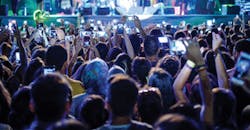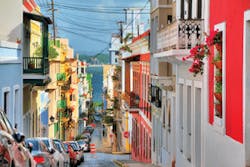Latest from 5G/6G & Fixed Wireless Access/Mobile Evolution
5 American Cities Need Major Network Upgrades —
It has been nearly 100 years since America crossed the demographic milestone where more people lived in cities than in rural areas. Towns once considered "the boondocks" have become nearby suburbs, and urban sprawl has led to giant metropolitan regions that span hundreds of miles and string together dozens of municipalities. However, despite the fact that we live in an always-connected era, many parts of the US are endangered by substandard infrastructure.
Here are 5 cities across the US that require attention.
CITY 1: Houston, Texas
In 2017, Texas made headlines for implementing Senate Bill 1004, which allowed the construction of network nodes in public rights-of-way. While hotly debated, these small connection points attached to light poles, traffic signal poles, and street sign poles, do boost signal quality.1
Houston plans to install 1,500 network nodes, which will go far to improve connectivity; however, there’s a complication: a single carrier controls performance, network reliability, and network speed.2
On a daily basis, this is not a concern. However, during an emergency, it’s easy to imagine how one network provider’s damaged towers could leave residents out of touch. By contrast, McAllen, Texas, demonstrated greater network parity, which helps take the load off a single provider.3
The Hudson Valley is plagued by widespread dead zones.
CITY 2: Hudson Valley, New York
Hudson Valley consistently ranks amongst the worst-network performing areas in the nation (or dead last, as it did in 2017).4 Network reliability and call performance are of highest concern, and it’s not carrier-specific, either.
So how can we improve connectivity in the Hudson Valley? Pretty much anything will help. The area suffers from multiple, widespread dead zones in specific rural areas that have long been identified.
But despite knowledge of the problem, neither carriers or public funding has prioritized installing new towers or testing COWs, or "cells on wheels." It’s a dangerous situation that endangers residents whose emergency calls may be rerouted, sometimes more than once, or dropped altogether. Those delays can cost lives.
CITY 3: Omaha, Nebraska
Omaha, Nebraska, often places at, or close to, the lowest ranking in the US in several areas of wireless performance, but unlike the Hudson Valley, Omaha shows signs of improvement. In a recent examination of the Omaha market, providers’ general rankings in performance and network reliability are on the upswing. Things are getting better, and in Omaha’s case, providers should keep doing exactly what they’re doing — because it’s beginning to work.5 We will continue to watch Omaha.
Coachella Music Festival has changed the network needs of Indio, California.
CITY 4: Indio, California
Indio, California, best known as the home to the Coachella Music Festival, ranks higher performance-wise, than some locations in the US (Hartford, Connecticut, for example), but it requires attention due to its annual influx of visitors during the festival.6
Rural Indio has spotty cell phone coverage, and each year, attendees of Coachella experience the same issues. With so many people descending into town each year, it’s time to address the problems. It’s a safety concern not only for festival-goers, but also for Indio residents. Network performance, reliability, and speed ratings, have remained unchanged, with only text performance improving.7
San Juan, PR should be prioritized for network improvements.
CITY: San Juan, Puerto Rico
All storm-prone areas must take extra steps to ensure networks can weather a storm — literally. In Puerto Rico, 91% of residents lost wireless coverage after Hurricane Maria decimated the island.8 We have suggested changes in the past such as installing small cell sites throughout the island next to master power stations. And as Puerto Rico’s largest city, San Juan, is the right place to start fortifying the island’s telecommunications infrastructure.
In addition, providers need more detailed and actionable plans to resume operations in the future, using the last storm’s monumental impact as a case study for what went wrong. Since it may be too late to make a significant impact prior to the 2018 hurricane season, let’s hope Puerto Rico escapes another storm this summer.
Sources
1. Smith, Brandi, author. Cell Phone Poles Going up on Houston Sidewalks. KCEN, 19 July 2017, www.kcentv.com/article/news/local/cell-phone-poles-going-up-on-houston-sidewalks/457877160.
2. "2nd Half 2017 Metro Area RootScore Report: Houston, Texas." RootMetrics, IHS Markit Company, Feb. 2018, rootmetrics.com/en-US/rootscore/map/metro/houston-tx/2017/2H.
3. Gaw, Alex. "Mobile Network Performance across the US: Our Complete Metro Area Rankings 1H 2017." RootMetrics, IHS Markit Company, 17 Aug. 2017, https://www.rootmetrics.com/en-US/rootscore/map/metro/houston-tx/2017/2H.
4. "2nd Half 2017 Metro Area RootScore Report: Hudson Valley, New York." RootMetrics, IHS Markit Company, Feb. 2018, https://www.rootmetrics.com/en-US/rootscore/map/metro/hudson-valley-ny/2017/2H.
5. "1st Half 2018 Metro Area RootScore Report: Omaha, Nebraska." RootMetrics, IHS Markit Company, https://www.rootmetrics.com/en-US/rootscore/map/metro/omaha-ne/2018/1H.
6. Pena, Xochitl. "As Coachella Festival Continues to Grow, Check out These Cool, New Features." Desert Sun, 13 Apr. 2018, www.desertsun.com/story/life/entertainment/music/coachella/2018/04/13/five-new-and-cool-things-see-coachella-festival/500964002/.
7. "2nd Half 2017 Metro Area RootScore Report: Indio, California." RootMetrics, IHS Markit Company, Feb. 2018, rootmetrics.com/en-US/rootscore/map/metro/indio-ca/2017/2H.
8. Weise, Elizabeth. "Puerto Rico Is Nearly Entirely Cut off from Cellphone Service, Leading to Low Tech Solutions." USA Today, 28 Sept. 2017, www.usatoday.com/story/tech/2017/09/28/puerto-rico-cell-phone-service-tmobile-att-hurricane/710775001/.








